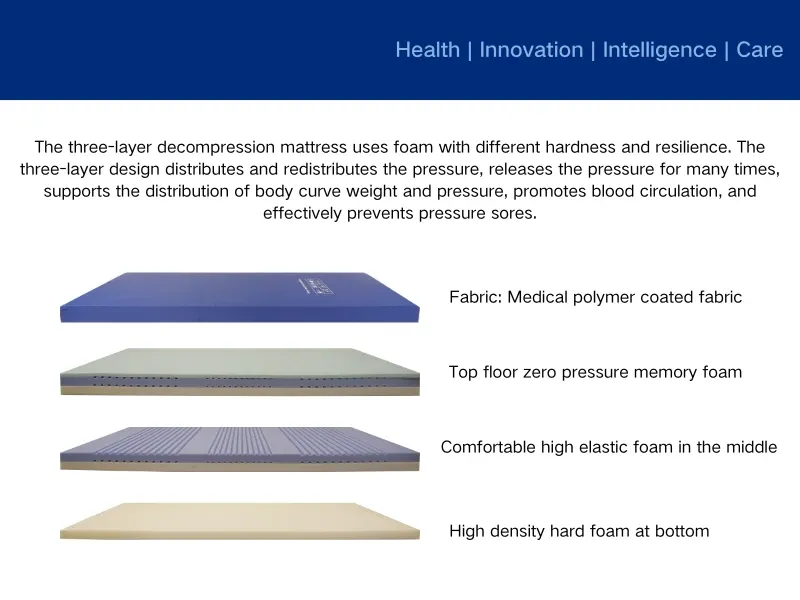From ICU to Home Care: Expanding the Use of Silicon Mattresses for Nursing Needs
The transition of silicone mattress technology from intensive care units to home environments marks a significant advancement in patient care across the healthcare continuum. Originally developed as specialized mattress for adjustable hospital bed systems, these innovative support surfaces have demonstrated such remarkable clinical benefits that their use is now expanding into post-acute and long-term care settings. The unique properties of silicone gel mattress designs - particularly their ability to prevent pressure injuries while maintaining patient comfort - make them ideally suited to address the growing needs of an aging population receiving care outside traditional hospital settings.

Silicone Mattress Clinical Foundations: Why Silicone Works
The effectiveness of silicone mattress technology stems from its unique viscoelastic properties that outperform traditional foam materials in clinical applications. Medical-grade silicone gel mattress constructions provide dynamic pressure redistribution that automatically adjusts to a patient's body contours, weight distribution, and movements without requiring manual adjustments or power sources. This passive yet sophisticated support mechanism proved invaluable in ICU settings as part of comfortable hospital bed mattress systems, where critically ill patients often cannot reposition themselves. The material's open-cell structure allows for exceptional airflow while maintaining structural integrity, preventing the heat buildup and moisture retention that contribute to skin breakdown. These inherent characteristics translate perfectly to home care environments where reliability and low maintenance are paramount considerations for caregivers and patients alike.
Silicone Mattress: Adapting Hospital Technology for Home Use
The migration of silicone bed mattress technology from institutional to residential settings has required thoughtful engineering adaptations. While maintaining the core pressure-relieving benefits of ICU-grade mattress for adjustable hospital bed systems, manufacturers have developed thinner, lighter versions that fit standard home beds and adjustable frames. These home-appropriate silicone gel mattress designs often incorporate removable, washable covers that maintain hygiene without professional cleaning equipment. Simplified versions of the sensor technology used in hospital models now alert home caregivers to potential pressure points through basic indicator systems. Perhaps most importantly, the newest generation of home silicone mattress products have been designed for easier handling and transfer, recognizing that most home caregivers lack the mechanical lifts and multiple staff available in hospital environments.
Silicone Mattress: Economic and Practical Benefits for Home Care
The long-term cost-effectiveness of silicone bed mattress systems makes them particularly suitable for home care applications. Unlike alternating pressure systems that require pumps and periodic maintenance, the silicone gel mattress provides continuous protection through its intrinsic material properties without moving parts or power requirements. The exceptional durability of medical-grade silicone - typically lasting 5-7 years in home use compared to 1-2 years for conventional foam - offsets the higher initial investment, especially important for families managing long-term care expenses. As a comfortable hospital bed mattress technology adapted for home use, these surfaces also reduce caregiver burden by minimizing the frequency of required patient repositioning, often decreasing turn schedules from every 2 hours to every 4-6 hours while maintaining skin integrity.
Silicone Mattress: Specialized Applications in Home Settings
The versatility of silicone mattress technology allows for targeted solutions to common home care challenges. Bariatric versions provide adequate support for larger patients without bottoming out, a frequent issue with conventional home mattresses. Low-profile designs facilitate safer transfers for patients with mobility limitations. Some silicone bed mattress products now incorporate phase-change materials to help regulate temperature for patients with thermoregulation disorders. For patients transitioning from hospital to home with existing pressure injuries, therapeutic silicone gel mattress systems can continue the wound healing process without requiring complex, equipment-intensive alternatives. These specialized applications demonstrate how hospital-grade technology can be successfully adapted to meet diverse home care needs while maintaining clinical efficacy.
Silicone Mattress: Improving Quality of Life Beyond Pressure Prevention
The benefits of comfortable hospital bed mattress technology in home environments extend far beyond pressure ulcer prevention. Patients report significantly improved sleep quality on silicone mattress surfaces compared to standard home mattresses, particularly important for those with chronic pain or limited mobility. The material's vibration dampening properties reduce disturbance from caregiver movements or bed adjustments. For patients spending extended periods in bed, the silicone gel mattress helps maintain proper spinal alignment and reduces joint pain associated with prolonged immobility. Perhaps most importantly, these surfaces preserve patient dignity by resembling conventional bedding while providing clinical-grade support, avoiding the institutional appearance of many medical mattresses that can negatively impact psychological wellbeing.
Silicone Mattress: Implementation Considerations for Home Adoption
Successful integration of silicone bed mattress technology into home care requires addressing several practical considerations. Caregivers need education about the different feel and response time of silicone compared to traditional mattresses, as the slower rebound can initially seem like inadequate support. The increased weight of some mattress for adjustable hospital bed designs may require verification of home bed frame capacity, especially for older or lightweight frames. Families should understand proper cleaning techniques to maintain hygiene without damaging the silicone core. Perhaps most crucially, insurance coverage and reimbursement pathways for these advanced surfaces in home settings continue to evolve, requiring proactive navigation by care teams and families to make this technology accessible to those who need it most.
The expansion of silicone bed mattress technology from ICUs to home environments represents an important step forward in creating seamless, high-quality care across all settings. By bringing hospital-grade pressure injury prevention and patient comfort into residences, these advanced surfaces help bridge the dangerous gap that often exists between institutional and home care standards. The adaptation of mattress for adjustable hospital bed technology for home use demonstrates how innovative medical solutions can be successfully translated to benefit patients wherever they receive care. As the evidence base grows and reimbursement pathways develop, silicone mattress systems will likely become standard of care for high-risk patients in home settings, preventing complications before they develop and improving quality of life for both patients and their caregivers. This technology transfer from ICU to home exemplifies the kind of innovation needed to support our aging population's desire to receive quality care in the comfort of their own homes.
-
The Science Behind Silicon Mattresses for Critical Care EnvironmentsȘtiriJul.16,2025
-
The Role of Wave Mattress Systems in Pressure Ulcer PreventionȘtiriJul.16,2025
-
The Role of ICU Nursing Silicon Mattress in Preventing Pressure UlcersȘtiriJul.16,2025
-
Long-Term Bedridden Patients and the Advantages of Silicon Mattresses in the ICUȘtiriJul.16,2025
-
Choosing the Right Wave Mattress for Different Levels of Patient CareȘtiriJul.16,2025
-
The Effect of Coconut Foam Mattress Breathability and Humidity Regulation on Improving Sleep QualityȘtiriJul.03,2025
-
How Wave Mattress Systems Improve Blood Circulation During ImmobilityȘtiriJul.03,2025

